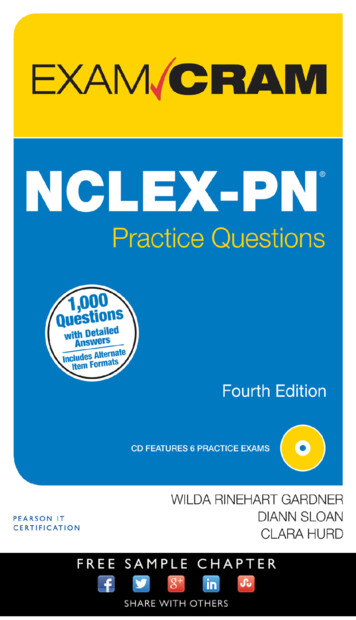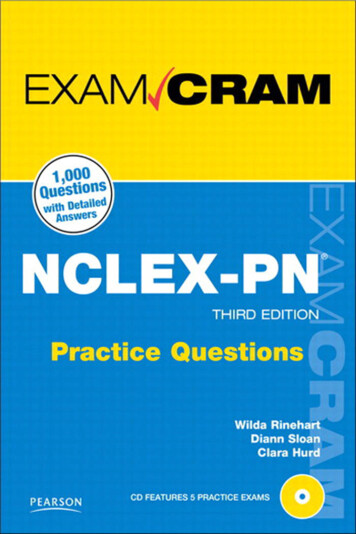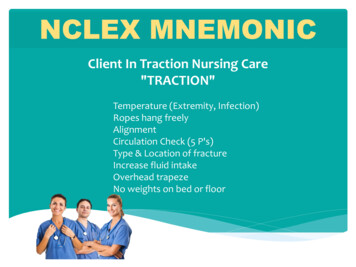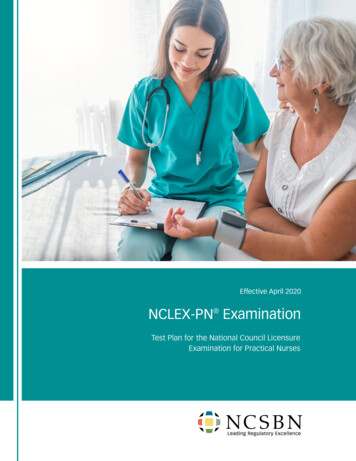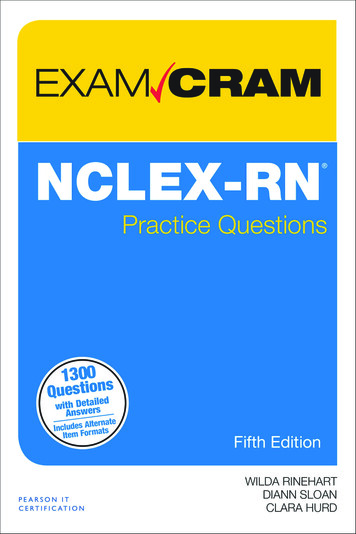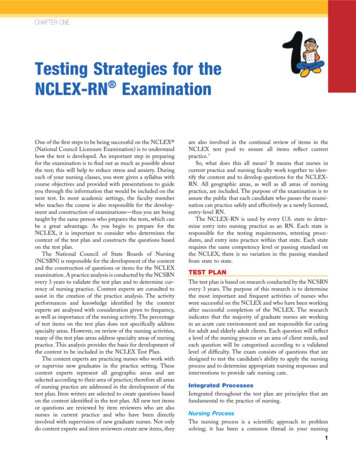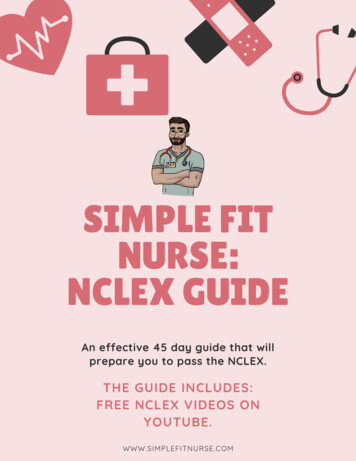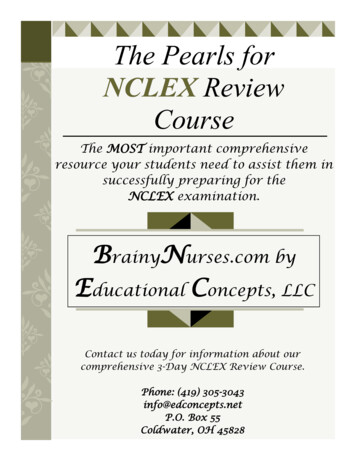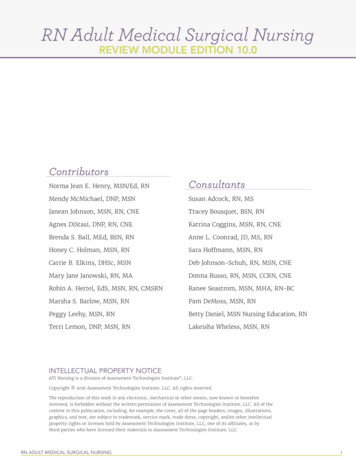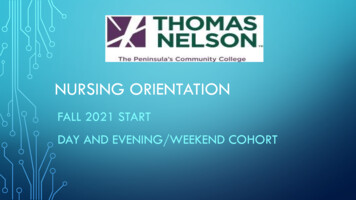
Transcription
NCLEX-RN Cram Sheet by2019 UpdateThis NCLEX-RN cram sheet or cheat sheet can help you prepare as it contains condensed facts about the nurse licensure exam itself and key nursing information. When your time totake the NCLEX comes, you can write or transfer these vital information from your head to a blank sheet of paper provided by the testing center.Please download only at Nurseslabs.com as we continually update this cram sheet.1.TEST INFORMATION2.NCLEX QUESTION TYPES3. Six hours – the maximum time allotted for the NCLEX is 6hours.Take breaks – Take breaks if you need a time out orneed to move around. First optional break is offered after2 hours of testing, next is offered after 3.5 hours of testing.All breaks count to your allotted six hours.75/265 – the minimum number of question you cananswer is 75 and a maximum of 265. Of the 75 questions,60 will be scored question and the remaining 15 arepretest or unscored questions.Read the question and answers carefully – do not jumpinto conclusions or make wild guesses. Read the entiretyof the question including its choices before selecting yourfinal answer.Look for keywords – avoid answers with absolutes likealways, never, all, every, only, must, except, none, or no.Don’t read into the question – Never assume anythingthat has not been specifically mentioned and don’t addextra meaning to the question.Eliminate answers that are clearly wrong or incorrect– to increase your probability of selecting the correctanswer!Watch for grammatical inconsistencies – Subjects andverbs should agree. If the question is an incompletesentence, the correct answer should complete thequestion in a grammatically correct manner.Rephrase the question – putting the question into yourown words can pluck the unneeded info and reveal thecore of the stem.Make an educated guess – if you can’t make the bestanswer for a question after carefully reading it, choose theanswer with the most information.New question types – New question types are added onthe test. These questions are found on the SpecialResearch Section of the test, which pops up after thecandidate finishes the exam. These do not count towardyour score and are testing out the feasibility of the testquestion, not the test-taker. Multiple-Choice –These questions provide you with dataabout client situation and given four options to choosefrom. Most common question type.Fill-in-the-Blank – This format is usually used formedication calculation or computing an IV flow rate. Typeonly a number for your answer in the box. Rounding ananswer should be done at the end of the calculation or aswhat the question specifies. Type in the decimal point ifnecessary.Multiple-Response – You’ll be asked to select all theoption that relate to the information asked by the question.There may be two or more correct answers and no partialcredit is given for correct selection.Ordered-Response – In this format, you’ll be asked touse the computer mouse to drag and drop your nursingactions in order or priority. Based on the informationpresented, determine what you’ll do first, second, third,and so forth. Directions are provided with the question.Figure or Hotspot – A picture or graphic will bepresented along with a question. This could contain achart, a table, or an illustration where you’ll be asked topoint or click on a specific area. Figures may also appearalong with a multiple-choice question.Chart/Exhibit – A chart or exhibit is presented along witha problem. You’ll be provided with three tabs or buttonsthat you need to click to obtain the information needed toanswer the question.Graphic Option – In this format, options are picturesrather than text. Each option is preceded by a circle thatyou need to click to represent your answer.Audio – In this format, you’ll be required to listen to asound to answer the question. You’ll need to use theheadset provided and click on the sound icon for it to play.You’ll be able to listen to the sound as many times asnecessary.Video – This will require viewing of an animation or videoclip to answer the accompanying question.Heart rateRespiratory rateBlood pressureTemperature 4.VITAL SIGNSHEMATOLOGY ophilsBasophilsPlateletsHemoglobin (Hgb)Hematocrit (Hct)5.4.5 – 5.0 million per mm34,500 – 11,000 per mm360 – 70%20 – 25%3 – 8%2 – 4%0.5 – 1%150,000– 400,000 per mm312 – 16 gm (F);14 – 18 gm (M).37 – 47 (F);40 – 54 (M)SERUM mPhosphorus6.80 – 100 bpm12-20 rpm110-120/60 mmHg37 C (98.6 F)135 – 145 mEq/L3.5 – 5.0 mEq/L8.6–10 mg/dL98 – 107 mEq/L1.2 – 2.6 mg/dL2.7-4.5 mg/dLACID- BASE BALANCEUse the ABG Tic-Tac-Toe Method for interpreting. Learn aboutthe technique at: (https://bit.ly/abgtictactoe).pH7.35 – 7.45HCO322 – 26 mEq/LPco235 – 45 mmHgPaO280–100 mmHgSaO2 95Notice: Please download this NCLEX-RN Cram Sheet only at Nurseslabs.We are continually updating the cram sheet with new info and you can only be assured to get the latest and updated version by downloading it from our site.Thank you! The link is: https://nurseslabs.com/nclex-cram-sheet/
7.CHEMISTRY VALUESGlucoseBUNSerum creatinineLDHProteinAlbuminBilirubinTotal CholesterolTriglycerideUric acidCPK8.URINE TEST NORMAL VALUESColorOdorTurbiditypHSpecific BacteriaRBCWBCUric Acid9.70 – 110 mg/dL7-22 mg/dL0.6 – 1.35 mg/dL100-190 U/L6.2 – 8.1 g/dL3.4 – 5.0 g/dL 1.0 mg/dL130 – 200 mg/dL40 – 50 mg/dL3.5 – 7.5 mg/dL21-232 U/LPale yellowSpecific aromatic odor, similar toammoniaClear4.5 – 7.81.016 to 1.022 0.5 g/dayNoneNoneNoneNone to fewNoneNone or 1000/mL 3 cells/HPF 4 cells/HPF250–750 mg/24 hrNORMAL GLUCOSE VALUESGlucose, fastingGlucose, monitoringGlucose tolerance test, oral Baseline fasting 30-min fasting 60-min fasting 90-min fasting 120-min fastingGlucose, 2-hourpostprandial70 – 110 mg/dL60 – 100 mg/dL70 – 110 mg/dL110 – 170 mg/dL120 – 170 mg/dL100 – 140 mg/dL70 – 120 mg/dL 140 mg/dL10. THERAPEUTIC DRUG LEVELS13. UNIT CONVERSIONSAcetaminophen (Tylenol)Carbamazepine (Tegretol)Digoxin (Lanoxin)Gentamycin (Garamycin)1 teaspoon (t)1 tablespoon (T)1 oz1 cup1 quart1 pint1 grain (gr)1 gram (g)1 kilogram (kg)1 lbConvert C to FLithium (Eskalith)Magnesium sulfatePhenobarbital (Solfoton)Phenytoin (Dilantin)SalicylateTheophylline (Aminophylline)Tobramycin (Tobrex)Valproic Acid (Depakene)Vancomycin (Vancocin)10-20 mcg/mL4 – 10 mcg/mL0.5 – 2.0 ng/mL5 – 10 mcg/ml (peak), 2.0 mcg/ml (valley)0.5 – 1.2 mEq/L4 – 7 mg/dL15 – 40 mcg/mL10 – 20 mcg/dL100 – 250 mcg/mL10 – 20 mcg/dL5 – 10 mcg/mL (peak),0.5 – 2.0 mcg/mL (valley)50 – 100 mcg/ml20 – 40 mcg/ml (peak),5 to 15 mcg/ml (trough)11. CARDIAC MARKERSCreatinine kinase (CK) CK-MB CK-MM CK-BBTroponin ITroponin TMyoglobinAtrial natriuretic peptides (ANP)Brain natriuretic peptides (BNP)26 – 174 units/L0%-5% of total95%-100% of total0% 0.6 ng/mL ( 1.5 ng/mLindicates MI) 0.1-0.2 ng/mL indicates MI 90 mcg/L; elevation indicatesMI22 – 27 pg/mL 100 pg/mL12. ANTICOAGULANT THERAPYSodium warfarin(Coumadin) PTINR (Coumadin)Heparin PTTAPTTFibrinogen level10 – 12 seconds (control). Theantidote is Vitamin K.0.9 – 1.230 – 45 seconds (control). Theantidote is protamine sulfate.3 – 31.9 seconds203 – 377 mg/dL5 ml3 t (15 ml)30 ml8 oz2 pints2 cups60 mg1,000 mg2.2 lbs16 ozmultiply by 1.8 then add32Convert F to C:subtract 32 then divideby 1.814. MATERNITY NORMAL VALUES Fetal Heart Rate: 120 – 160 bpmVariability: 6 – 10 bpmAmniotic fluid: 500 – 1200 mlContractions: 2 – 5 minutes apart with duration of 90seconds and intensity of 100 mmHg.AVA: The umbilical cord has two arteries and one vein.15. APGAR SCORING Appearance, Pulses, Grimace, Activity, Reflex Irritability.Done at 1 and 5 minutes with a score of 0 for absent, 1 fordecreased, and 2 for strongly positive.Scores 7 and above are generally normal, 4 to 6 fairly low,and 3 and below are generally regarded as critically low.16. EPIDURAL ANESTHESIA: STOP STOP is a treatment for maternal hypotension after anepidural anesthesia.Stop infusion of Pitocin.Turn the client on her left side.Oxygen therapy.Push IV fluids, if hypovolemia is present.2SOURCE: https://nurseslabs.com/nclex-cram-sheet/
17. PREGNANCY CATEGORY OF DRUGS Category A – No risk in controlled human studiesCategory B – No risk in other studies. Examples:Amoxicillin, Cefotaxime.Category C – Risk not ruled out. Examples: Rifampicin(Rifampin), Theophylline (Theolair).Category D – Positive evidence of risk. Examples:Phenytoin, Tetracycline.Category X – Contraindicated in Pregnancy. Examples:Isotretinoin (Accutane), Thalidomide (Immunoprin), etc.Category N – Not yet classified18. DRUG SCHEDULES Schedule I – no currently accepted medical use and forresearch use only (e.g., heroin, LSD, MDMA).Schedule II – drugs with high potential for abuse andrequires written prescription (e.g., Ritalin, hydromorphone(Dilaudid), meperidine (Demerol), and fentanyl).Schedule III – requires new prescription after six monthsor five refills (e.g., codeine, testosterone, ketamine).Schedule IV – requires new prescription after six months(e.g., Darvon, Xanax, Soma, and Valium).Schedule V – dispensed as any other prescription orwithout prescription (e.g., cough preparations, Lomotil,Motofen). 20. RULE OF NINES Digoxin (Lanoxin) – Assess pulses for a full minute, ifless than 60 bpm hold dose. Check digitalis andpotassium levels.Aluminum Hydroxide (Amphojel) – Treatment of GERDand kidney stones. WOF constipation.Hydroxyzine (Vistaril) – Treatment of anxiety and itching.WOF dry mouth.Amiodarone (Cordarone) – WOF diaphoresis, dyspnea,lethargy. Take missed dose any time in the day or to skipit entirely. Do not take double dose.Warfarin (Coumadin) – WOF for signs of bleeding,diarrhea, fever, or rash. Stress importance of complyingwith prescribed dosage and follow-up appointments.Methylphenidate (Ritalin) – Treatment of ADHD. Assessfor heart related side-effects and reported immediately.Child may need a drug holiday because the drug stuntsgrowth.Dopamine – Treatment of hypotension, shock, and lowcardiac output. Monitor ECG for arrhythmias and bloodpressure.Rifampicin – causes red-orange tears and urine.Ethambutol – causes problems with vision, liver problem.Isoniazid – can cause peripheral neuritis, take vitamin B6to counter.22. DEVELOPMENTAL MILESTONES For calculating Total Body Surface Area (TBSA) for burns:Head and neck: 9%Upper limbs: 18% (9% each)Anterior torso: 18%Posterior torso: 18%Legs: 36% (18% each)Genitalia: 1%21. MEDICATIONS19. MEDICATION CLASSIFICATIONSAntacids – reduces hydrochloric acid in the stomach.Antianemics – increases blood cell production.Anticholinergics – decreases oral secretions.Anticoagulants – prevents clot formation,Anticonvulsants – used for management of seizuresand/or bipolar disorders.Antidiarrheals – decreases gastric motility and reducewater in bowel.Antihistamines – block the release of histamine.Antihypertensives – lower blood pressure and increasesblood flow.Anti-infectives – used for the treatment of infections,Bronchodilators – dilates large air passages in asthmaor lung diseases (e.g., COPD).Diuretics – decreases water/sodium from the Loop ofHenle.Laxatives – promotes the passage of stool.Miotics – constricts the pupils.Mydriatics – dilates the pupils.Narcotics/analgesics – relieves moderate to severe pain. 2 – 3 months: able to turn head up, and can turn side toside. Makes cooing or gurgling noises and can turn headto sound.4 – 5 months: grasps, switch and roll over tummy to back.Can babble and can mimic sounds.6 – 7 months: sits at 6 and waves bye-bye. Canrecognize familiar faces and knows if someone is astranger. Passes things back and forth between hands.8 – 9 months: stands straight at eight, has favorite toy,plays peek-a-boo.10 – 11 months: belly to butt.12 – 13 months: twelve and up, drinks from a cup. Crieswhen parents leave, uses furniture to cruise.Midazolam (Versed) – given for conscious sedation.Watch out for (WOF) respiratory depression andhypotension.3SOURCE: https://nurseslabs.com/nclex-cram-sheet/
23. CULTURAL CONSIDERATIONS African Americans – May believe that illness is caused by supernatural causes and seek advice and remedies form faith healers; they are family oriented; have higher incidence of high bloodpressure and obesity; high incidence of lactose intolerance with difficulty digesting milk and milk products.Arab Americans – May remain silent about health problems such as STIs, substance abuse, and mental illness; a devout Muslim may interpret illness as the will of Allah, a test of faith; may rely onritual cures or alternative therapies before seeking help from health care provider; after death, the family may want to prepare the body by washing and wrapping the body in unsewn white cloth;postmortem examinations are discouraged unless required by law. May avoid pork and alcohol if Muslim. Islamic patients observe month long fast of Ramadan (begins approximately mid-October);people suffering from chronic illnesses, pregnant women, breast-feeding, or menstruating don’t fast. Females avoid eye contact with males; use same-sex family members as interpreters.Asian Americans – May value ability to endure pain and grief with silent stoicism; typically family oriented; extended family should be involved in care of dying patient; believes in “hot-cold” yin/yangoften involved; sodium intake is generally high because of salted and dried foods; may believe prolonged eye contact is rude and an invasion of privacy; may not without necessarily understanding;may prefer to maintain a comfortable physical distance between the patient and the health care provider.Latino Americans – May view illness as a sign of weakness, punishment for evil doing; may consult with a curandero or voodoo priest; family members are typically involved in all aspects ofdecision making such as terminal illness; may see no reason to submit to mammograms or vaccin
08.01.2021 · NCLEX-RN Cram Sheet by 2019 Update This NCLEX-RN cram sheet or cheat sheet can help you prepare as it contains condensed facts about the nurse licensure exam

